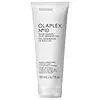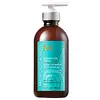What's inside
What's inside
 Key Ingredients
Key Ingredients

 Benefits
Benefits

 Concerns
Concerns

 Ingredients Side-by-side
Ingredients Side-by-side

Water
Skin ConditioningXylitylglucoside
HumectantHydroxyethylcellulose
Emulsion StabilisingAnhydroxylitol
HumectantBis-Aminopropyl Diglycol Dimaleate
Skin ConditioningGlycerin
HumectantPropanediol
SolventMaltitol
HumectantPolyimide-1
Guar Hydroxypropyltrimonium Chloride
Skin ConditioningHydroxypropyl Starch Phosphate
Caprylyl/Capryl Glucoside
CleansingXylitol
HumectantAspergillus Ferment
Skin ConditioningAcacia Senegal Gum
MaskingEthylhexylglycerin
Skin ConditioningCetyl Hydroxyethylcellulose
Emulsion StabilisingPolyquaternium-10
Glycolipids
Skin ConditioningArginine
MaskingCocos Nucifera Oil
MaskingPersea Gratissima Oil
Skin ConditioningSodium Cocoyl Glutamate
CleansingOlive Oil Polyglyceryl-6 Esters
EmollientSodium Hydroxide
BufferingCitric Acid
BufferingTrisodium Ethylenediamine Disuccinate
Glyceryl Caprylate
EmollientGlyceryl Stearate
EmollientPg-Hydroxyethylcellulose Cocodimonium Chloride
Lactic Acid
BufferingCetearyl Alcohol
EmollientCocos Nucifera Fruit Juice
EmollientCocos Nucifera Water
MaskingGlyceryl Undecylenate
EmollientPhospholipids
Skin ConditioningPolyglyceryl-10 Dioleate
EmulsifyingPolyglyceryl-10 Oleate
Skin ConditioningSodium Stearoyl Lactylate
EmulsifyingPelvetia Canaliculata Extract
Skin ProtectingDisodium Phosphate
BufferingHydrated Silica
AbrasiveSilica Dimethyl Silylate
EmollientPhenoxyethanol
PreservativePotassium Sorbate
PreservativeSodium Benzoate
MaskingParfum
MaskingLimonene
PerfumingHexyl Cinnamal
PerfumingLinalool
PerfumingCitral
PerfumingCitronellol
PerfumingWater, Xylitylglucoside, Hydroxyethylcellulose, Anhydroxylitol, Bis-Aminopropyl Diglycol Dimaleate, Glycerin, Propanediol, Maltitol, Polyimide-1, Guar Hydroxypropyltrimonium Chloride, Hydroxypropyl Starch Phosphate, Caprylyl/Capryl Glucoside, Xylitol, Aspergillus Ferment, Acacia Senegal Gum, Ethylhexylglycerin, Cetyl Hydroxyethylcellulose, Polyquaternium-10, Glycolipids, Arginine, Cocos Nucifera Oil, Persea Gratissima Oil, Sodium Cocoyl Glutamate, Olive Oil Polyglyceryl-6 Esters, Sodium Hydroxide, Citric Acid, Trisodium Ethylenediamine Disuccinate, Glyceryl Caprylate, Glyceryl Stearate, Pg-Hydroxyethylcellulose Cocodimonium Chloride, Lactic Acid, Cetearyl Alcohol, Cocos Nucifera Fruit Juice, Cocos Nucifera Water, Glyceryl Undecylenate, Phospholipids, Polyglyceryl-10 Dioleate, Polyglyceryl-10 Oleate, Sodium Stearoyl Lactylate, Pelvetia Canaliculata Extract, Disodium Phosphate, Hydrated Silica, Silica Dimethyl Silylate, Phenoxyethanol, Potassium Sorbate, Sodium Benzoate, Parfum, Limonene, Hexyl Cinnamal, Linalool, Citral, Citronellol
Water
Skin ConditioningParaffinum Liquidum
EmollientCetyl Alcohol
EmollientPolyquaternium-7
Glyceryl Stearate
EmollientDimethicone
EmollientPetrolatum
EmollientArgania Spinosa Kernel Oil
EmollientTocopheryl Acetate
AntioxidantPanthenol
Skin ConditioningParfum
MaskingDMDM Hydantoin
PreservativeCetrimonium Chloride
AntimicrobialCitric Acid
BufferingCitronellol
PerfumingLimonene
PerfumingAlpha-Isomethyl Ionone
PerfumingHexyl Cinnamal
PerfumingHydroxycitronellal
PerfumingIsoeugenol
PerfumingLinalool
PerfumingWater, Paraffinum Liquidum, Cetyl Alcohol, Polyquaternium-7, Glyceryl Stearate, Dimethicone, Petrolatum, Argania Spinosa Kernel Oil, Tocopheryl Acetate, Panthenol, Parfum, DMDM Hydantoin, Cetrimonium Chloride, Citric Acid, Citronellol, Limonene, Alpha-Isomethyl Ionone, Hexyl Cinnamal, Hydroxycitronellal, Isoeugenol, Linalool
Ingredients Explained
These ingredients are found in both products.
Ingredients higher up in an ingredient list are typically present in a larger amount.
Citric Acid is an alpha hydroxy acid (AHA) naturally found in citrus fruits like oranges, lemons, and limes.
Like other AHAs, citric acid can exfoliate skin by breaking down the bonds that hold dead skin cells together. This helps reveal smoother and brighter skin underneath.
However, this exfoliating effect only happens at high concentrations (20%) which can be hard to find in cosmetic products.
Due to this, citric acid is usually included in small amounts as a pH adjuster. This helps keep products slightly more acidic and compatible with skin's natural pH.
In skincare formulas, citric acid can:
While it can provide some skin benefits, research shows lactic acid and glycolic acid are generally more effective and less irritating exfoliants.
Most citric acid used in skincare today is made by fermenting sugars (usually from molasses). This synthetic version is identical to the natural citrus form but easier to stabilize and use in formulations.
Read more about some other popular AHA's here:
Learn more about Citric AcidCitronellol is used to add fragrance/parfum to a product. It is often derived from plants such as roses. In fact, it can be found in many essential oils including geranium, lavender, neroli, and more. The scent of Citronellol is often described as "fresh, grassy, and citrus-like".
Since the Citronellol molecule is already unstable, Citronellol becomes irritating on the skin when exposed to air.
Citronellol is a modified terpene. Terpenes are unsaturated hydrocarbons found in plants. They make up the primary part of essential oils.
Citronellol is not able to be absorbed into deeper layers of the skin. It has low permeability,
Citronellol is also a natural insect repellent.
Learn more about CitronellolGlyceryl Stearate is a mix of glycerin and stearic acid.
It is used to stabilize the mixing of water and oil ingredients. By preventing these ingredients from separating, it can help elongate shelf life. It can also help thicken the product's texture.
As an emollient, it helps soften skin and supports barrier-replenishing ingredients.
In cosmetics, Glyceryl Stearate is often made from vegetable oils or synthetically produced.
This ingredient may not be fungal-acne safe
Fun fact: The human body also creates Glyceryl Stearate naturally.
Learn more about Glyceryl StearateHexyl Cinnamal is a fragrance ingredient with a similar scent to jasmine. It can be naturally found in chamomile essential oil.
This ingredient is a known EU allergen and may sensitize the skin. The EU requires this ingredient to be listed separately on an ingredients list.
Hexyl Cinnamal is not water soluble but is soluble in oils.
Learn more about Hexyl CinnamalLimonene is a fragrance that adds scent and taste to a formulation.
It's found in the peel oil of citrus fruits and other plants such as lavender and eucalyptus. The scent of limonene is generally described as "sweet citrus".
Limonene acts as an antioxidant, meaning it helps neutralize free radicals.
When exposed to air, oxidized limonene may sensitize the skin. Because of this, limonene is often avoided by people with sensitive skin.
The term 'fragrance' is not regulated in many countries. In many cases, it is up to the brand to define this term. For instance, many brands choose to label themselves as "fragrance-free" because they are not using synthetic fragrances. However, their products may still contain ingredients such as essential oils that are considered a fragrance.
Learn more about LimoneneLinalool is a fragrance and helps add scent to products. It's derived from common plants such as cinnamon, mint, citrus, and lavender.
Like Limonene, this ingredient oxidizes when exposed to air. Oxidized linalool can cause allergies and skin sensitivity.
This ingredient has a scent that is floral, spicy tropical, and citrus-like.
Learn more about LinaloolParfum is a catch-all term for an ingredient or more that is used to give a scent to products.
Also called "fragrance", this ingredient can be a blend of hundreds of chemicals or plant oils. This means every product with "fragrance" or "parfum" in the ingredients list is a different mixture.
For instance, Habanolide is a proprietary trade name for a specific aroma chemical. When used as a fragrance ingredient in cosmetics, most aroma chemicals fall under the broad labeling category of “FRAGRANCE” or “PARFUM” according to EU and US regulations.
The term 'parfum' or 'fragrance' is not regulated in many countries. In many cases, it is up to the brand to define this term.
For instance, many brands choose to label themselves as "fragrance-free" because they are not using synthetic fragrances. However, their products may still contain ingredients such as essential oils that are considered a fragrance by INCI standards.
One example is Calendula flower extract. Calendula is an essential oil that still imparts a scent or 'fragrance'.
Depending on the blend, the ingredients in the mixture can cause allergies and sensitivities on the skin. Some ingredients that are known EU allergens include linalool and citronellol.
Parfum can also be used to mask or cover an unpleasant scent.
The bottom line is: not all fragrances/parfum/ingredients are created equally. If you are worried about fragrances, we recommend taking a closer look at an ingredient. And of course, we always recommend speaking with a professional.
Learn more about ParfumWater. It's the most common cosmetic ingredient of all. You'll usually see it at the top of ingredient lists, meaning that it makes up the largest part of the product.
So why is it so popular? Water most often acts as a solvent - this means that it helps dissolve other ingredients into the formulation.
You'll also recognize water as that liquid we all need to stay alive. If you see this, drink a glass of water. Stay hydrated!
Learn more about Water